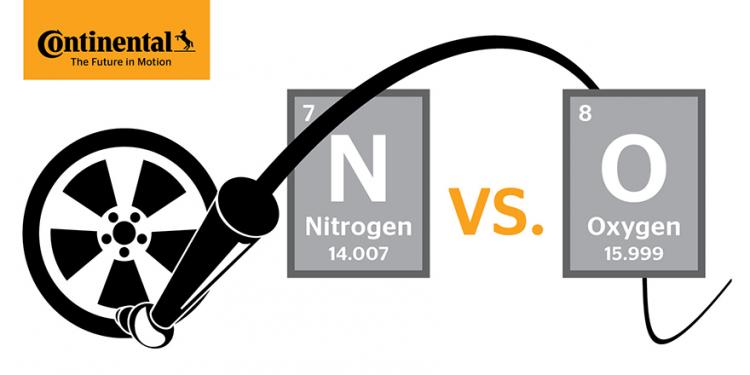
Nitrogen is offered as an alternative to air for tire inflation. But is it right for you?
Tires are designed and built to provide many miles of excellent service but must be properly maintained. The key element of proper tire maintenance is maintaining the recommended tire inflation pressure. The proper tire inflation pressure is recommended by the vehicle manufacturer and can be found on the vehicle’s tire placard or in the vehicle owner’s manual. Continental Tire recommends that the consumer check his/her tire inflation pressure at regular intervals of at least once per month and before every long trip or, twice per month depending on local regulations, customs, or conditions.
Now, the basics. All gasses expand when heated and contract when cooled, and tire inflation pressures are no different. Tire inflation pressure can rise and fall with changes in ambient temperature by about one psi (pound per square inch) for every 10 degrees Fahrenheit. Thus, it is recommended that you check tire pressures early in the morning before the sun’s heat or heat generated by driving causes the tire pressure to rise.
Using Nitrogen in Tires
So why is nitrogen used? In its pure form, nitrogen has been used primarily because it doesn’t support moisture or combustion. Nitrogen is an inert (non-flammable) gas – basically, nothing more than dry air with oxygen removed. In fact, ambient air contains about 78% nitrogen, 21% oxygen and 1% miscellaneous gas. Because of nitrogen’s inert properties, it is often used in highly specialized tire service applications and/or demanding environments. These tire service applications usually include aircraft, mining, and commercial/heavy use. Also, nitrogen is used in professional auto racing where extreme vehicle speeds are involved. Dry nitrogen is used in this regard to help reduce tire pressure variations where even small differences in pressure can affect vehicle handling at the extreme limits of performance.
Is Nitrogen Right For Me?
For normal everyday consumer tire service applications, nitrogen tire inflation is not required.
However, nitrogen tire inflation does not harm tires and may marginally contribute to reductions in tire inflation loss by permeation. Nevertheless, nitrogen will not prevent any tire inflation loss caused by punctures, tire/rim interface (bead) leaks, valve leaks, valve/rim interface leaks, wheel leaks, and other mechanical leaks. Again, the use of nitrogen alone does not substitute for the importance of regularly checking tire inflation pressure. If the tire inflation pressure is below the pressure specified on the vehicle placard, the tire must be re-inflated – whether with air or nitrogen – to the proper inflation pressure. Do not operate tires underinflated and/or overloaded (see your vehicle owner’s manual for tire inflation and max load recommendations).
Bottom Line - Check Your Tire Pressures
Whether inflated with air or nitrogen, regular tire inflation pressure maintenance remains critical and necessary. Use of nitrogen alone is not a replacement for regular tire inflation pressure maintenance. Underinflation, and/or overloading tires, will create excessive stresses and heat build-up that can lead to tire disablement by a tread-belt separation and/or detachment, causing serious injury or death.
Take five minutes at the beginning of each month to check your tire pressures…and don’t forget the spare! This will save money and headaches down the road. For further questions, consult your local Continental Tire dealer.
